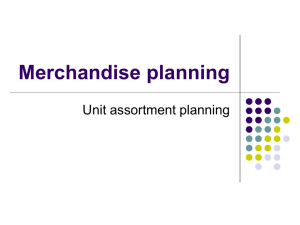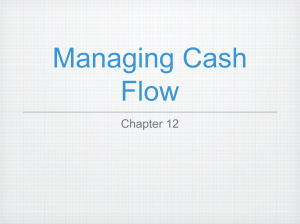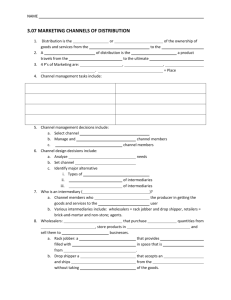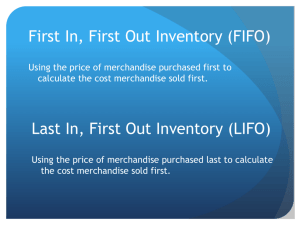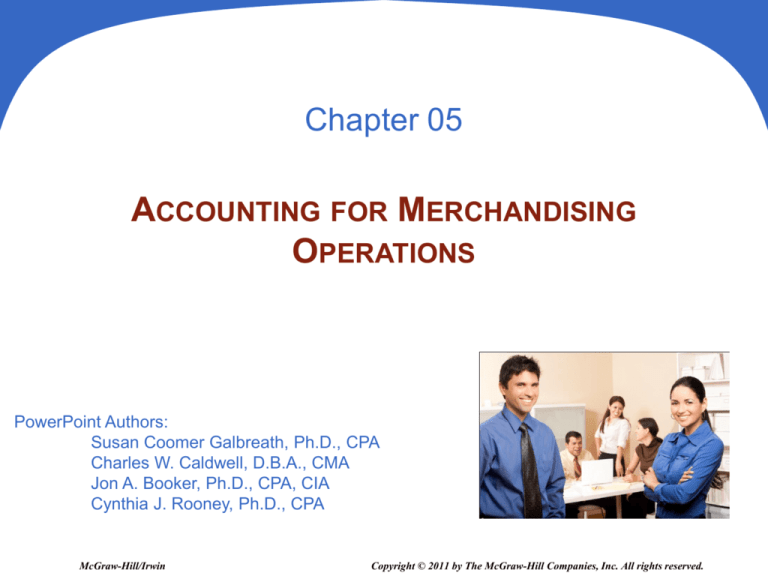
Chapter 05
ACCOUNTING FOR MERCHANDISING
OPERATIONS
PowerPoint Authors:
Susan Coomer Galbreath, Ph.D., CPA
Charles W. Caldwell, D.B.A., CMA
Jon A. Booker, Ph.D., CPA, CIA
Cynthia J. Rooney, Ph.D., CPA
McGraw-Hill/Irwin
Copyright © 2011 by The McGraw-Hill Companies, Inc. All rights reserved.
5-2
C1
SERVICE COMPANIES
Service organizations sell time to
earn revenue.
Examples: Accounting firms, law firms and
plumbing services
5-3
C1
MERCHANDISER
Merchandising Companies
Manufacturer
Wholesaler
Retailer
Consumers
5-4
C1
REPORTING INCOME FOR A
MERCHANDISER
Merchandising companies sell products
to earn revenue.
Examples: sporting goods, clothing, and auto parts stores
5-5
C2
OPERATING CYCLE FOR A
MERCHANDISER
Begins with the purchase of merchandise
and ends with the collection of cash from the
sale of merchandise.
5-6
C2
INVENTORY SYSTEMS
5-7
C2
INVENTORY SYSTEMS
Perpetual systems
continually update
accounting records for
merchandising
transactions
Periodic systems
accounting records
relating to merchandise
transactions are
updated only at the end
of the accounting period
5-8
P1
MERCHANDISE PURCHASES
On November 2, Z-Mart purchased $1,200 of
merchandise inventory for cash.
5-9
P1
TRADE DISCOUNTS
Used by manufacturers and wholesalers
to offer better prices for greater
quantities purchased.
Example
Z-Mart offers a 30% trade
discount for orders of 1,000
units or more on its popular
product Racer. Each
Racer has a list price of $5.25.
Quantity sold
Price per unit
Total
Less 30% discount
Invoice price
1,000
$ 5.25
5,250
(1,575)
$ 3,675
5 - 10
P1
ACCOUNTING FOR MERCHANDISE
PURCHASES
5 - 11
P1
PURCHASE DISCOUNTS
A deduction from the invoice price granted to
induce early payment of the amount due.
5 - 12
P1
PURCHASE DISCOUNTS
2/10,n/30
Discount
Percent
Number of
Days
Discount Is
Available
Otherwise,
Net (or All)
Is Due in 30
Days
Credit
Period
5 - 13
P1
PURCHASE DISCOUNTS
On November 2, Z-Mart purchased $1,200 of
merchandise inventory on account, credit
terms are 2/10, n/30.
5 - 14
P1
PURCHASE DISCOUNTS
On November 12, Z-Mart paid the amount
due on the purchase of November 2.
5 - 15
P1
PURCHASE DISCOUNTS
After we post these entries, the accounts involved
look like these:
5 - 16
P1
PURCHASE RETURNS AND
ALLOWANCES
Purchase Return . . .
Merchandise returned by the purchaser to
the supplier.
Purchase Allowance . . .
A reduction in the cost of defective or
unacceptable merchandise received by a
purchaser from a supplier.
5 - 17
P1
PURCHASE RETURNS AND
ALLOWANCES
On November 15, Z-Mart (buyer) issues a
$300 debit memorandum for an allowance
from Trex for defective merchandise.
5 - 18
P1
PURCHASE RETURNS AND
ALLOWANCES
Z-Mart purchases $1,000 of merchandise on June 1 with
terms 2/10, n/60. Two days later, Z-Mart returns $100 of
goods before paying the invoice. When Z-Mart later pays
on June 11, it takes the 2% discount only on the $900
remaining balance.
5 - 19
P1
TRANSPORTATION COSTS AND
OWNERSHIP TRANSFER
5 - 20
P1
TRANSPORTATION COSTS
Z-Mart purchased merchandise on terms of FOB
shipping point. The transportation charge is
$75.
5 - 21
P1
ACCOUNTING FOR MERCHANDISE
5 - 22
P2
ACCOUNTING FOR MERCHANDISE
SALES
5 - 23
P2
SALES OF MERCHANDISE
Each sales transaction for a seller of
merchandise involves two parts:
Revenue received in
the form of an asset
from a customer.
Recognition of the
cost of merchandise
sold to a customer.
5 - 24
P2
SALES OF MERCHANDISE
On November 3, Z-Mart sold $2,400 of
merchandise on credit. The merchandise has a
cost basis to Z-Mart of $1,600.
5 - 25
P2
SALES DISCOUNTS
Sales discounts on credit sales can benefit a seller by
decreasing the delay in receiving cash and reducing future
collection efforts.
5 - 26
P2
SALES DISCOUNTS
Z-Mart completes a $1,000 credit sale with terms of 2/10, n/60.
The account was paid in full within the 60-day period.
The account was paid in full within the 10-day discount period.
5 - 27
P2
SALES RETURNS AND ALLOWANCES
Sales returns and allowances usually involve
dissatisfied customers and the possibility of
lost future sales.
Sales returns refer
to merchandise that
customers return to
the seller after a
sale.
Sales allowances
refer to reductions in
the selling price of
merchandise sold to
customers.
5 - 28
P2
SALES RETURNS AND ALLOWANCES
Recall Z-Mart’s sale for $2,400 that had a cost
of $1,600. Assume the customer returns part of
the merchandise. The returned items sell for
$800 and cost $600.
Sales Returns and Allowances is a Contra Account subtracted from sales
Defective inventory valued at estimated value not its cost
5 - 29
P2
SALES ALLOWANCES
Assume that $800 of the merchandise Z-Mart
sold on November 3 is defective but the buyer
decides to keep it because Z-Mart offers a
$100 price reduction. Sales Allowance
5 - 30
MERCHANDISING COST FLOW IN
THE ACCOUNTING CYCLE
P2
Period 2
Period 1
Beginning
inventory
Net
purchases
Merchandise
available for sale
Ending
inventory
Cost of
goods sold
Beginning
inventory
Net
purchases
To Income Statement
To Balance Sheet
Merchandise
available for sale
Ending
inventory
Cost of
goods sold
To Income Statement
To Balance Sheet
P3
ADJUSTING ENTRIES FOR
MERCHANDISERS
A merchandiser using a perpetual inventory system is
usually required to make an adjustment to update the
Merchandise Inventory account to reflect any loss of
merchandise, including theft and deterioration.
Z-Mart’s Merchandise Inventory account at the end of
year 2011 has a balance of $21,250, but a physical
count reveals that only $21,000 of inventory exists.
Inventory Shrinkage difference of physical count and recorded inventory
5 - 31
P3
CLOSING ENTRIES FOR
MERCHANDISERS
5 - 32
5 - 33
P4
A multiple-step
income
statement
format shows
detailed
computations
of net sales
and other
costs and
expenses, and
reports
subtotals for
various
classes of
items.
5 - 34
P4
SINGLE-STEP INCOME STATEMENT
5 - 35
CLASSIFIED BALANCE SHEET
Highly
Liquid
Less
Liquid
5 - 36
GLOBAL VIEW
Accounting for Merchandise Purchases and Sales
Both U.S. GAAP and IFRS include broad and similar guidance
for the accounting of merchandise purchases and sales.
1.
2.
3.
4.
5.
6.
Financial Statement Differences
Order of expenses
Separate disclosures
Presentation of expenses
Classification of operating and
nonoperating expenses
Alternative measures of income
Order of current and noncurrent
items on the balance sheet
5 - 37
A1
ACID-TEST RATIO
Acid-Test
Ratio
Acid-Test
=
Ratio
=
Quick Assets
Current Liabilities
Cash + S-T Investments + Receivables
Current Liabilities
A common rule of thumb is the acid-test ratio should have a
value of at least 1.0 to conclude a company is unlikely to
face liquidity problems in the near future.
5 - 38
A2
GROSS MARGIN RATIO
Gross
Margin =
Ratio
Net Sales - Cost of Goods Sold
Net Sales
Percentage of dollar
sales available to
cover expenses and
provide a profit.
5 - 39
A1/A2
JCPENNEY
5 - 40
P5
APPENDIX 5A:
PERIODIC INVENTORY SYSTEM
(a)
(b)
(c)
(d)
(e)
(f)
(g)
A periodic inventory system requires updating the inventory account only at the end of a
period to reflect the quantity and cost of both the goods available and the goods sold.
5 - 41
P5
APPENDIX 5A:
PERIODIC INVENTORY SYSTEM
5 - 42
P5
APPENDIX 5B:
WORKSHEET—PERPETUAL SYSTEM
5 - 43
END OF CHAPTER 05

